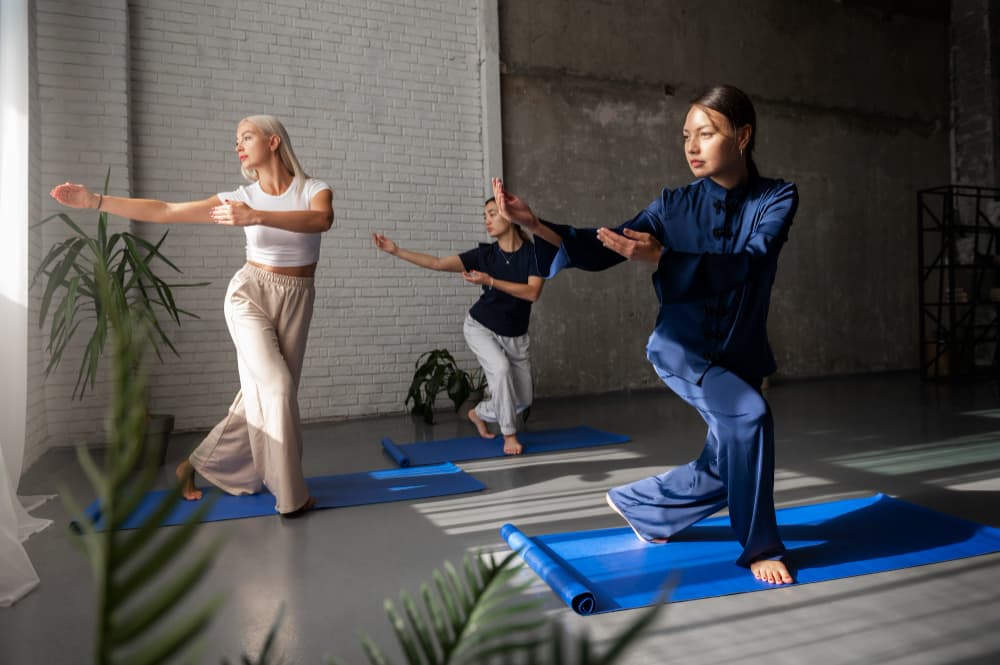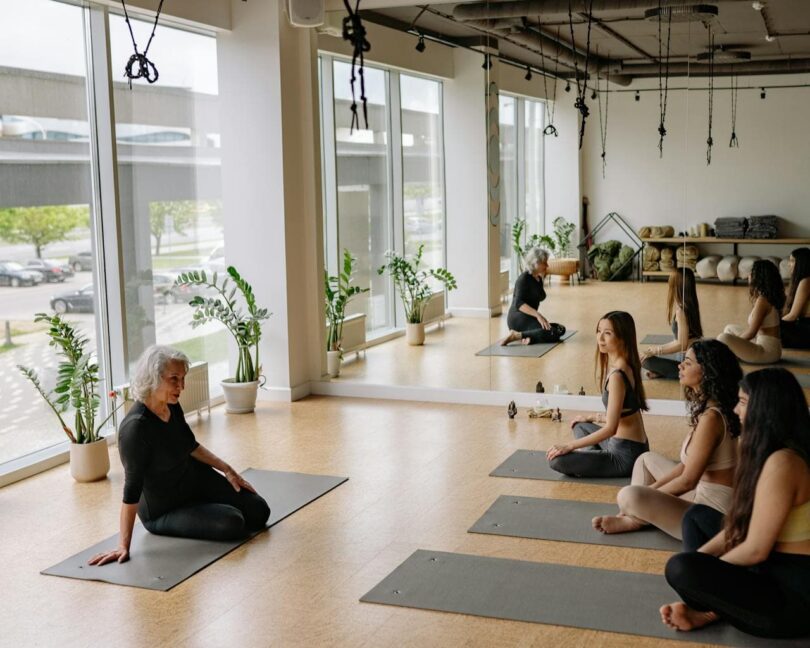Table of Contents
Introduction
Yoga is not just a physical practice; it’s a holistic approach to well-being that encompasses the mind, body, and spirit. The role of yoga teachers is crucial in guiding students through this journey. Effective instruction involves understanding core principles, utilizing various teaching techniques, and creating an inclusive environment. This article will delve into these aspects, providing insights and tips for yoga instructors based on top sources, including the New York Times.
Introduction to Yoga Teacher Instruction
Teaching yoga goes beyond merely guiding poses. It’s about fostering a connection between the mind, body, and spirit while ensuring safety and accessibility for all students. Good instruction can transform a yoga session into a profound, enriching experience.
The Role of Yoga Teachers
Understanding the Teacher’s Role
A yoga teacher’s role is multifaceted, involving not only the physical instruction of asanas but also the cultivation of an environment conducive to mental and emotional growth. Teachers must be adept at reading their students’ needs and offering adjustments and modifications where necessary.
Responsibilities of a Yoga Instructor
Yoga instructors have a responsibility to continue their own education, stay updated with the latest practices, and maintain a personal practice. This commitment helps them provide the best possible guidance to their students.

Core Principles of Yoga Instruction
Alignment and Safety
Alignment is fundamental in yoga practice. Proper alignment ensures that students practice poses safely, preventing injuries and maximizing benefits. Yoga teachers should always emphasize the importance of alignment and be vigilant in correcting students’ postures.
Breath Control (Pranayama)
Breath control, or pranayama, is a cornerstone of yoga. Effective instruction involves teaching students how to control their breath to enhance their practice. This includes techniques like deep belly breathing, ujjayi breath, and alternate nostril breathing.
Mindfulness and Meditation
Mindfulness and meditation are integral to yoga. Teachers should guide students in focusing their minds, whether through seated meditation or mindful movement during asanas. This helps in achieving a deeper connection with the practice.
Instruction Techniques and Methods
Verbal Instruction
Clear and concise verbal instructions are essential. Yoga teachers must articulate each step of a pose with precision, making sure all students can follow along. Using descriptive language helps students create vivid mental images.
Physical Adjustments
When appropriate, physical adjustments can aid students in achieving correct alignment. However, it’s crucial to seek consent and be mindful of personal boundaries. Adjustments should be gentle and supportive, enhancing the student’s understanding of the pose.
Demonstration
Sometimes, a visual demonstration is the best way to convey how a pose should be performed. Teachers should use demonstrations to break down complex poses, showing proper form and variations.
Creating an Inclusive Environment
Welcoming All Students
Creating an inclusive environment means ensuring that everyone, regardless of their skill level or physical condition, feels welcome. This involves offering modifications and using props to make poses accessible to all.
Safety and Comfort
Safety and comfort are paramount in any yoga class. Teachers should check in with students about any injuries or conditions and adapt their instruction accordingly. Providing a space where students feel comfortable and secure allows them to fully engage in their practice.
By focusing on these aspects, yoga teachers can provide high-quality instruction that benefits their students in numerous ways. The journey of teaching yoga is one of continuous learning and dedication, ultimately leading to a more fulfilling practice for both teachers and students.
Challenges Faced by Yoga Teachers
Common Challenges
Balancing Different Skill Levels
One of the biggest challenges yoga teachers face is addressing the varying skill levels within a single class. Some students may be beginners, while others might have years of experience. Finding a balance that keeps everyone engaged and challenged without feeling overwhelmed is key. Offering modifications and advanced variations can help cater to different abilities.
Maintaining Student Engagement
Keeping students engaged throughout the class is another hurdle. Repetitive routines can lead to boredom, while overly complex sequences can cause frustration. Yoga teachers need to keep classes fresh and interesting by introducing new poses, themes, or variations while maintaining a sense of flow and coherence.
Physical and Emotional Burnout
Teaching yoga, while rewarding, can also be physically and emotionally draining. Teachers often give a lot of their energy to their students, which can lead to burnout if not managed properly. It’s important for yoga instructors to practice self-care, set boundaries, and take time for their own practice to maintain their well-being.
Managing Diverse Student Needs
Addressing Physical Limitations
Students come to yoga with a variety of physical limitations, whether due to injury, age, or other conditions. Teachers must be adept at offering modifications and using props to make poses accessible to everyone. This requires a deep understanding of anatomy and the ability to think on their feet.
Emotional Support
Yoga can bring up emotional responses, and teachers must be prepared to handle these situations with sensitivity and care. Creating a supportive environment where students feel safe to express their emotions is crucial. Teachers should also know when to refer students to professional help if needed.
Continuous Learning and Development
Staying Updated with Latest Practices
Yoga is an evolving practice, and it’s essential for teachers to stay informed about the latest developments and trends. This can involve attending workshops, participating in advanced training, and reading relevant literature. Continuous learning not only improves teaching skills but also keeps the practice fresh and engaging for both teachers and students.
Incorporating Student Feedback
Listening to and incorporating student feedback is vital for growth. It helps teachers understand what works and what doesn’t in their classes, allowing them to make necessary adjustments. This feedback loop creates a more responsive and effective teaching environment.
By recognizing and addressing these challenges, yoga teachers can improve their teaching practices and create a more enriching experience for their students. It’s a journey of constant learning and adaptation, ensuring that both teachers and students benefit from the practice of yoga.
Related Article: Ashtanga Yoga Teacher Training: Comprehensive Guide 2024
Enhancing Teaching Skills
Continuous Learning and Development
Importance of Ongoing Education
For yoga teachers, ongoing education is crucial. Attending workshops, seminars, and advanced training sessions helps keep their knowledge up-to-date. This not only broadens their understanding of yoga but also introduces them to new techniques and approaches that can be integrated into their teaching.
Personal Practice
Maintaining a personal yoga practice is essential for teachers. It allows them to experience the practice from a student’s perspective, which can inform their teaching. Personal practice also helps in staying connected to the essence of yoga, fostering a deeper understanding and empathy towards their students.
Utilizing Feedback for Improvement
Gathering Feedback
Constructive feedback from students is invaluable. It provides insights into what works well and what needs adjustment in a class. Teachers should create an open environment where students feel comfortable sharing their thoughts and experiences. This can be done through casual conversations, feedback forms, or anonymous surveys.
Implementing Changes
Once feedback is gathered, it’s important to act on it. Making adjustments based on student feedback shows that teachers value their students’ opinions and are committed to improving their teaching. This could involve tweaking class structures, modifying the pace, or introducing new elements based on student preferences.
Developing a Unique Teaching Style
Finding Your Voice
Every yoga teacher has a unique style that reflects their personality and approach to yoga. Developing this unique voice involves being authentic and true to oneself. It’s about bringing personal experiences, knowledge, and passion into the teaching, which can deeply resonate with students.
Building Confidence
Confidence in teaching comes with experience and practice. New teachers might feel nervous or unsure at first, but with time, they develop the confidence to lead classes effectively. Practicing teaching in front of friends or family, seeking mentorship, and continuously refining their skills can help build this confidence.
Staying Inspired and Motivated
Seeking Inspiration
Staying inspired is essential for yoga teachers. Inspiration can come from various sources – reading books, attending classes with other teachers, practicing different styles of yoga, or even exploring related disciplines like meditation or mindfulness. Keeping the spark alive ensures that teaching remains a joyful and fulfilling experience.
Avoiding Burnout
To prevent burnout, teachers need to balance their teaching with self-care. This includes setting boundaries, taking regular breaks, and engaging in activities that rejuvenate their body and mind. Self-care ensures that they can continue to teach with energy and enthusiasm.
Related Article: St Marks Yoga: A Holistic Haven for Mind and Body
Case Studies and Real-Life Examples
Successful Yoga Teachers
Case Study: Sarah’s Inclusive Yoga Class
Sarah, a yoga teacher based in California, has been teaching for over ten years. She noticed that many beginners felt intimidated by advanced classes and that students with physical limitations struggled to keep up. To address this, Sarah started offering a range of modifications and using props extensively. Her inclusive approach made her classes accessible to everyone, regardless of their physical condition or experience level.
Sarah’s use of props like blocks, straps, and chairs allows students to find versions of poses that work for their bodies. She emphasizes the importance of listening to one’s body and offers gentle encouragement rather than pushing students to go beyond their limits. This approach has built a loyal following of students who feel supported and seen in her classes.
Case Study: John’s Focus on Breath and Mindfulness
John is a yoga instructor who teaches in a busy urban studio. He observed that many of his students came to yoga as a way to cope with stress and anxiety. To help his students, John integrated a strong focus on pranayama (breath control) and mindfulness into his classes.
He starts each class with a short guided meditation to center the students and then incorporates various breathing techniques throughout the session. This emphasis on breath helps students stay present and manage stress better. John’s classes have become a sanctuary for many who seek not only physical benefits but also mental clarity and calm.
Real-Life Teaching Examples
Example: Adapting to Online Teaching
With the rise of online yoga classes, many teachers have had to adapt their methods. For instance, Jessica, a yoga teacher from New York, quickly transitioned to virtual classes during the pandemic. She found that teaching online posed unique challenges, such as maintaining student engagement and ensuring proper alignment without being physically present.
Jessica addressed these challenges by being very clear and descriptive in her verbal instructions. She also made use of technology, employing multiple camera angles to demonstrate poses and using interactive tools like chat and feedback forms to stay connected with her students. Her ability to adapt quickly and effectively to the online format kept her students engaged and her classes thriving.
Example: Building a Community
Building a community is an essential part of teaching yoga. Mark, a yoga teacher in Seattle, has successfully created a strong sense of community among his students. He organizes monthly social events, charity drives, and group outings, which help students bond outside the studio.
Mark’s community-focused approach extends to his teaching style. He frequently encourages students to share their experiences and supports peer learning. This has created a welcoming and supportive environment where students feel a strong sense of belonging.
By examining these real-life examples and case studies, we can see how different yoga teachers address common challenges and innovate in their teaching methods. These stories highlight the importance of adaptability, inclusivity, and community-building in creating a successful and enriching yoga practice.
FAQs
How Can Beginners Find a Good Yoga Teacher?
Finding a good yoga teacher can significantly impact your practice. Beginners should look for instructors with proper certifications from recognized organizations like the Yoga Alliance. Attending a few trial classes can help gauge the teacher’s style and approach. It’s also helpful to read reviews or ask for recommendations from friends or online communities.
What Qualifications Should a Yoga Teacher Have?
A qualified yoga teacher should have completed a recognized teacher training program, typically a 200-hour course certified by the Yoga Alliance. Additional certifications in specialized areas, such as prenatal yoga or yoga therapy, can also be beneficial. Experience, ongoing education, and personal practice are also important markers of a dedicated and knowledgeable teacher.
How Can Yoga Teachers Continue Their Education?
Continuing education is vital for yoga teachers. They can attend workshops, advanced training sessions, and conferences to stay updated with new practices and techniques. Joining professional organizations like the Yoga Alliance provides access to resources and networking opportunities. Reading books, participating in online courses, and learning from experienced mentors are also great ways to continue growing as a teacher.
What Makes a Yoga Class Inclusive?
An inclusive yoga class accommodates students of all levels and abilities. This means offering modifications and using props to make poses accessible. A good teacher creates a welcoming atmosphere where everyone feels comfortable. Clear communication and sensitivity to individual needs are key to fostering an inclusive environment.
How Can Teachers Prevent Burnout?
Preventing burnout involves balancing teaching with self-care. Yoga teachers should set clear boundaries, take regular breaks, and engage in activities that rejuvenate them. Maintaining a personal practice, seeking support from peers, and finding time for rest and relaxation are crucial for sustaining energy and passion for teaching.
How Important is Feedback in Yoga Teaching?
Feedback is essential for growth and improvement. It helps teachers understand what works and what doesn’t in their classes. Constructive feedback from students provides valuable insights that can guide adjustments and refinements in teaching methods. Creating an open and honest feedback loop benefits both teachers and students.
How Do Online Yoga Classes Differ from In-Person Classes?
Online yoga classes present unique challenges and opportunities. Teachers need to be more descriptive in their instructions since physical adjustments aren’t possible. Using multiple camera angles and interactive tools can enhance the online learning experience. Despite the lack of physical presence, teachers can still foster a sense of community through virtual interactions and feedback.
Conclusion
Teaching yoga is a rewarding yet challenging profession that requires a deep understanding of both the practice and the students. Effective yoga instruction involves mastering core principles such as alignment, breath control, and mindfulness. By using varied teaching techniques and creating an inclusive environment, teachers can cater to the diverse needs of their students.
Yoga instructors face numerous challenges, from balancing different skill levels to managing their own physical and emotional well-being. Continuous learning, incorporating feedback, and developing a unique teaching style are crucial for personal and professional growth. Real-life examples and case studies highlight the importance of adaptability, inclusivity, and building a community.
By addressing frequently asked questions, we provide valuable insights into finding qualified teachers, continuing education, and maintaining an inclusive and supportive class environment. Preventing burnout and understanding the differences between online and in-person classes also play a significant role in sustaining a successful teaching career.
Ultimately, the journey of a yoga teacher is one of ongoing growth and dedication, aimed at enriching both their own practice and the lives of their students. By focusing on these key aspects, yoga teachers can offer effective and meaningful instruction, fostering a deeper connection and understanding of yoga for everyone involved.







